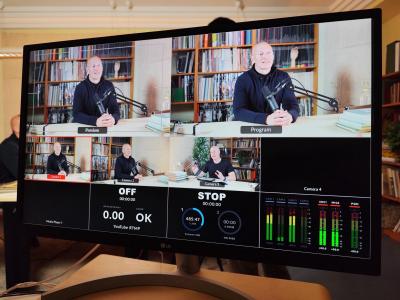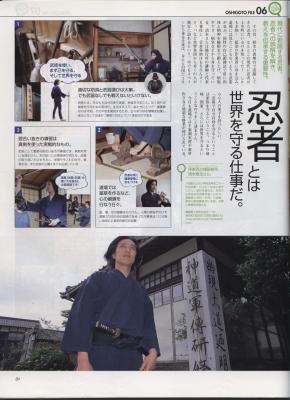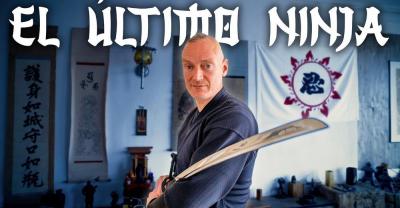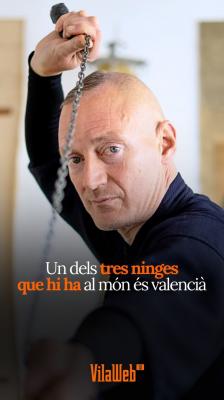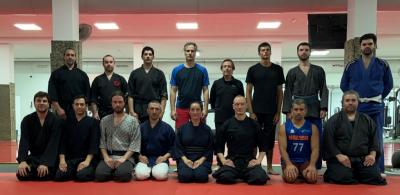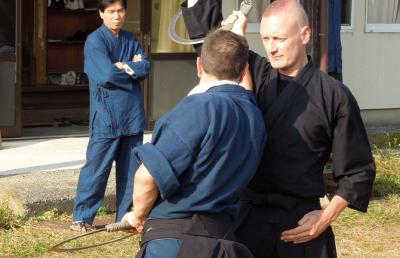Aquí os dejo la entrevista que me realizó Sergi Unanue hace unos días, está en catalán, para quien no lo entienda, he añadido aquí el texto en español e inglés. En la entrevista me refiero sólo a la tradición de mi escuela.
-Español:
En
casa tiene un arsenal de armas. Pero no son convencionales. Unas tijeras de podar, unas pinzas para la barbacoa, un tintero japonés, una aguja de coser o incluso un simple pañuelo. Todos, objetos cotidianos que podrían pasar desapercibidos sin delatar que quien los lleva, en realidad, sabe cómo utilizarlos de forma letal. Y es que los Shinobi eran los maestros del camuflaje, el espionaje y la discreción. Pero poco tienen que ver con las representaciones que ha hecho Hollywood.
Me lo explica mientras me enseña todo ese abanico inverosímil de armamento, José Defez, que es, nada menos, que uno de los tres únicos Shinobi que todavía hay hoy en día. De hecho, el término ninja nació hace relativamente poco en las representaciones culturales japonesas. El concepto más correcto históricamente es el de “Shinobi”.
“La función de los samuráis era la guerra. Los shinobi, además del entrenamiento samurái, también tenían uno específico para realizar trabajos más especiales, como el sabotaje, la infiltración, el espionaje o la recolección de información”, me comenta Defez en su gimnasio, ubicado en la planta baja de su casa, en una urbanización en las afueras de la ciudad de Valencia. “El entrenamiento de los samuráis era muy duro, pero el de los shinobi lo es aún más. Tienen que aguantar, resistir y sufrir para llegar a la fortaleza espiritual. Tienen que aguantar muchas cosas: el dolor, el frío, el calor… Era un trabajo mucho más duro.”
José da clases en su gimnasio de Valencia.
Pero este trabajo hace ya tiempo que desapareció. Sin embargo, José ha hecho todos estos entrenamientos. Ha habido que pasar días enteros sin comida, sin dormir, o directamente sin moverse. Un shinobi, por ejemplo, quizá debería entrar en una casa y esconderse dentro de un mueble sin hacer ruido, esperando el momento oportuno para robar algún documento, escuchar una conversación importante o asesinar a alguien. Entre las pruebas más duras, también hay resistencia al dolor. “Son entrenamientos en los que te golpean y tienes que soportar el dolor sin parar, sin emitir ningún gemido. Son muy difíciles. También hay que aguantar el frío y el calor. Es llevar al extremo todas las cosas. Son entrenamientos que te fortalecen la parte física y la mental, pero la más importante es la del espíritu, la voluntad, la fuerza para seguir aguantando pase lo que pase.” Curiosamente, el ninja valenciano asegura que las pruebas más complicadas son las de aguantar el picor. "Tienes que estar completamente quieto aunque te piquen insectos por todo el cuerpo durante horas".
Según José, su habilidad en hacer lo que le dijera el maestro sin rechistar es una de las claves para entender que se haya convertido en el primer extranjero de la historia en llegar al rango de “shihan”, que determina que tiene los conocimientos necesarios para ser considerado shinobi. Hoy en día, sólo hay otras dos personas con esta categoría o superior: su maestro, Yasushi Kiyomoto, y su maestro respectivo, Soke Jinichi Kawakami.
Una parte central de las enseñanzas Shinobi No Den son las técnicas de respiración.
Tuve la oportunidad de conocer a Kiyomoto en Japón, en un seminario en Koka, donde también me encontré a José Defez. En cuanto nos presentó, el maestro japonés me enseñó un pergamino centenario en el que había estampada con tinta una parte de los conocimientos shinobi que un ninja había escrito siglos atrás. “Durante el período Edo (1603-1868), el propósito de los ninjas era claro: proteger su vida, su familia, su área, su dominio, su país”, me dijo mientras conducía de vuelta a Kioto. “También hacían espionaje, asesinatos y sabotaje, pero esto ya no es necesario en Japón. Estos conocimientos, en la actualidad, podrían ser útiles sobre todo en caso de desastres. En estas situaciones puede ser útil soportar el frío y el hambre o saber curar heridas.”
Además, existe un buen puñado de aprendizajes que tienen aplicación en la vida moderna. Según Defez, andamos mal, respiramos mal y no utilizamos el máximo potencial de nuestros sentidos y nuestro cuerpo. "La gente está acostumbrada a cosas electrónicas modernas y tiene la mirada fija hacia adelante, pero por los lados no ve", explica. Por eso él mira que sus alumnos desarrollen sentidos como los de la vista o el oído, con pruebas que consisten, por ejemplo, en intentar escuchar una conversación ajena al tiempo que se habla con naturalidad con otro. También les hace ejercicios de memoria o les hace entrenar a oscuras. "No te da poderes, sólo te ayuda a aumentar el nivel de tus sentidos." Otra aplicación posible en la actualidad son las técnicas de respiración, que pueden ayudarte a calmarte o dormirte, además de la capacidad de reaccionar mejor a las desgracias que acompañan inevitablemente la vida de todos.
Éste es uno de los factores que cautivaron a José cuando empezó a practicar las destrezas shinobi, en el 2003. Había probado todo tipo de artes marciales pero no encontraba nada que “realmente funcionara, que se hubiera utilizado de verdad”. En un viaje a Japón conoció a Kawakami y Kiyomoto. Aquella experiencia le impactó. El Shinobi No Den era más que un arte marcial, era una forma de vivir. “Continuaré yendo a Japón y seguiré entrenando hasta que me muera”, se prometió a sí mismo. Desde entonces, una o dos veces cada año ha visitado el país del sol naciente, donde ha aprendido intensamente y, más adelante, ha llevado estas enseñanzas a nuevos alumnos a su dojo de Valencia. “Es una combinación de técnicas de respiración, de medicina tradicional china y japonesa, de artes marciales… Es una forma de vivir integral que nos ayuda en todos los aspectos.”
¿Qué hay de cierto en las películas?
La mayoría de nosotros, cuando oímos la palabra “ninja”, vemos, tras una humareda, un hombre vestido de negro de pies a cabeza, enseñando sólo los ojos, blandiendo unas estrellas ninja que lanza contra el enemigo mientras corre por encima de agua o salta de tejado en tejado. Muchas de estas cosas son "ridículas" vistas de la perspectiva shinobi.
Así era como ocultaban realmente el rostro por la noche, dejando espacio en la boca y en la nariz para respirar, con un pañuelo que podía servir, también, para camuflarse como una piedra, como flotador con calabazas, como mochila o como arma.
Por ejemplo, nunca irían de negro. Si el objetivo es camuflarse, tratarían de pasar desapercibidos e ir vestidos como el resto de la gente, más bien con ropa marrón o azul. Nunca traerían nada que pudiera delatarlos diferenciándolos del resto, como unas armas en forma de estrella que sólo ellos, supuestamente, utilizan. “No hay ningún documento histórico que demuestre que se han utilizado. Pesan mucho, hacen ruido si las llevas encima… Si quieres infiltrarte en una casa, el ruido te delata. Además, en épocas de guerra el acero es muy valioso. No irían arrojando estrellas, perdiendo acero. Si se estudia algo, esto parece ridículo. Es una ficción. Respetamos quien le guste, pero es una ficción.”
Si bien no tenían bombas de humo ni desaparecían por arte de magia, sí utilizaban técnicas curiosas que podían hacerlo pensar. En caso de persecución durante la noche en un bosque, por ejemplo, el shinobi podía encender algo de pólvora con una chispa para crear una pequeña explosión que lo iluminara todo un instante. Con esto ganaban tiempo hasta que las pupilas del perseguidor se volvieran a acostumbrar a la oscuridad para cubrirse con un pañuelo haciéndose pasar por una piedra. Ahora, si alguien optaba por buscarlos golpeándolos con palos o katana, debían ser capaces de mantener el silencio a pesar del dolor. Un gemido, en esta situación, podía significar la muerte.
Las enseñanzas Shinobi No Den están muy relacionadas con la cultura japonesa.
Imagen de Koka, hogar de los shinobi y de la escuela Ban, que practican Defez, Kiyomoto y Kawakami.
Lógicamente, estas técnicas no tienen aplicación en un mundo tan diferente al de Japón del período Edo. Pero son unos conocimientos ancestrales, con siglos de experiencia y puestos en práctica, que pueden caer en el olvido. Por eso, José quiere aprender en lo posible de todo aquello que intentaron transmitir los shinobi que le han precedido. "No es fácil, porque con el paso de los siglos el mantenimiento ha costado, pero ha llegado hasta nuestros días y es un tesoro muy importante que, por mi parte, de mis alumnos y de mis maestros en Japón, no se perderá."
Para ello ve claro que quiere priorizar la calidad a la cantidad. “Queremos calidad de la gente; por eso hacemos una entrevista personal al alumno antes de aceptarlo. Nos da igual cuántos seamos, queremos que sean personas que entiendan qué es esto y que nosotros sepamos que lo harán bien y que vale la pena enseñarles. Si pierdes la esencia de la escuela, pierdes parte de la escuela. Por eso en mi escuela preferimos que algún conocimiento se pierda a que se transmita mal. Porque si esto ocurre, se deteriora, no es puro, pierde la esencia y se rompe la tradición.”
------------------------------------------------------------------------
-English:
Here is the interview that Sergi Unanue conducted with me a few days ago, it is in Catalan, for those who do not understand it, I have added the text in Spanish and English here. In the interview I refer only to the tradition of my school.
At home he has an arsenal of weapons. But they are not conventional. Some pruning shears, some barbecue tongs, a Japanese inkwell, a sewing needle or even a simple handkerchief. All of them are everyday objects that could go unnoticed without revealing that the person wearing them actually knows how to use them in a lethal way. And the Shinobi were the masters of camouflage, espionage and discretion. But they have little to do with the representations that Hollywood has made.
He explains it to me while he shows me all that incredible range of weaponry, José Defez, who is, no less, one of the only three Shinobi that still exists today. In fact, the term ninja was born relatively recently in Japanese cultural representations. The most historically correct concept is that of “Shinobi”.
“The function of the samurai was war. The shinobi, in addition to samurai training, also had specific training to carry out more special jobs, such as sabotage, infiltration, espionage or information gathering,” Defez tells me in his gym, located on the ground floor of his house, in an urbanization on the outskirts of the city of Valencia. “The training of the samurai was very hard, but that of the shinobi is even more so. They have to endure, resist and suffer to reach spiritual strength. “They have to put up with many things: the pain, the cold, the heat… It was much harder work.”
José teaches classes at his gym in Valencia.
But this job has long since disappeared. However, José has done all these trainings. We have had to spend entire days without food, without sleeping, or without moving at all. A shinobi, for example, perhaps should enter a house and hide inside a piece of furniture quietly, waiting for the right moment to steal a document, listen to an important conversation, or kill someone. Among the toughest tests, there is also resistance to pain. “They are training sessions in which they hit you and you have to endure the pain without stopping, without making any moans. They’re very difficult. You also have to endure the cold and the heat. It is taking all things to the extreme. They are training that strengthens your physical and mental part, but the most important thing is that of the spirit, the will, the strength to continue holding on no matter what happens.” Curiously, the Valencian ninja assures that the most complicated tests are those of enduring the itch. "You have to be completely still even if insects bite you all over your body for hours."
According to José, his ability to do what the teacher told him without question is one of the keys to understanding why he has become the first foreigner in history to reach the rank of “shihan”, which determines that he has the necessary knowledge to be considered shinobi. Today, there are only two other people with this rank or higher: his teacher, Yasushi Kiyomoto, and his respective teacher, Soke Jinichi Kawakami.
A central part of the Shinobi No Den teachings are breathing techniques.
I had the opportunity to meet Kiyomoto in Japan, at a seminar in Koka, where I also met José Defez. As soon as he introduced us, the Japanese master showed me a centuries-old scroll on which he had stamped in ink a part of the shinobi knowledge that a ninja had written centuries ago. “During the Edo period (1603-1868), the purpose of the ninja was clear: to protect your life, your family, your area, your domain, your country,” he told me as he drove back to Kyoto. “They also did espionage, assassinations and sabotage, but this is no longer necessary in Japan. This knowledge, today, could be useful especially in the event of disasters. In these situations it can be useful to endure cold and hunger or know how to heal wounds.”
In addition, there are a good handful of learnings that have application in modern life. According to Defez, we walk badly, we breathe badly and we do not use the maximum potential of our senses and our body. "People are used to modern electronic things and they look straight ahead, but they don’t see to the sides," he explains. That is why he ensures that his students develop senses such as those of sight or hearing, with tests that consist, for example, of trying to listen to another’s conversation while speaking naturally with another. He also gives them memory exercises or makes them train in the dark. "It doesn’t give you powers, it just helps you increase the level of your senses." Another possible application today is breathing techniques, which can help you calm down or fall asleep, in addition to the ability to react better to the misfortunes that inevitably accompany everyone’s life.
This is one of the factors that captivated José when he started practicing shinobi skills in 2003. He had tried all kinds of martial arts but couldn’t find anything that “really worked, that was really used.” On a trip to Japan he met Kawakami and Kiyomoto. That experience impacted him. Shinobi No Den was more than a martial art, it was a way of life. “I will continue to go to Japan and continue training until I die,” he promised himself. Since then, once or twice each year he has visited the country of the rising sun, where he has learned intensely and, later, he has brought these teachings to new students at his dojo in Valencia. “It is a combination of breathing techniques, traditional Chinese and Japanese medicine, martial arts… It is a comprehensive way of living that helps us in all aspects.”
What is true in the movies?
Most of us, when we hear the word “ninja”, see, behind a cloud of smoke, a man dressed in black from head to toe, showing only his eyes, brandishing ninja stars that he throws at the enemy while running over water or jump from roof to roof. Many of these things are "ridiculous" views from the shinobi perspective.
This was how they really hid their faces at night, leaving space in their mouth and nose to breathe, with a scarf that could also be used to camouflage themselves as a rock, as a float with pumpkins, as a backpack or as a weapon.
For example, they would never wear black. If the objective is to camouflage, they would try to go unnoticed and dress like the rest of the people, rather in brown or blue clothing. They would never bring anything that could give them away, differentiating them from the rest, such as star-shaped weapons that only they, supposedly, use. “There is no historical document to prove that they have been used. They weigh a lot, they make noise if you carry them... If you want to infiltrate a house, the noise will give you away. Furthermore, in times of war steel is very valuable. They wouldn’t go around throwing stars, wasting steel. If you study anything, this seems ridiculous. It’s a fiction. We respect whoever likes it, but it is a fiction.”
Although they did not have smoke bombs or disappear by magic, they did use curious techniques that could make you think. In the event of a chase at night in a forest, for example, the shinobi could ignite some gunpowder with a spark to create a small explosion that illuminated everything for an instant. With this they bought time until the pursuer’s pupils became accustomed to the darkness to cover themselves with a scarf, pretending to be a stone. Now, if someone chose to look for them by hitting them with sticks or a katana, they had to be able to maintain silence despite the pain. A moan, in this situation, could mean death.
Shinobi No Den teachings are closely related to Japanese culture.
Image of Koka, home of the shinobi and the Ban school, practiced by Defez, Kiyomoto and Kawakami.
Logically, these techniques have no application in a world so different from that of Japan in the Edo period. But it is ancient knowledge, with centuries of experience and put into practice, that can be forgotten. For this reason, José wants to learn as much as possible from everything that the shinobi who have preceded him tried to transmit. "It is not easy, because over the centuries maintenance has been costly, but it has survived to this day and is a very important treasure that, for my part, my students and my teachers in Japan, will not be lost."
To do this, he sees clearly that he wants to prioritize quality over quantity. “We want quality of people; That is why we do a personal interview with the student before accepting them. He doesn’t care how many of us there are, we want them to be people who understand what this is and for us to know that they will do it well and that it is worth teaching them. If you lose the essence of the school, you lose part of the school. That’s why at my school we prefer that some knowledge be lost than that it be poorly transmitted. Because if this happens, it deteriorates, it is not pure, it loses its essence and the tradition is broken.”


